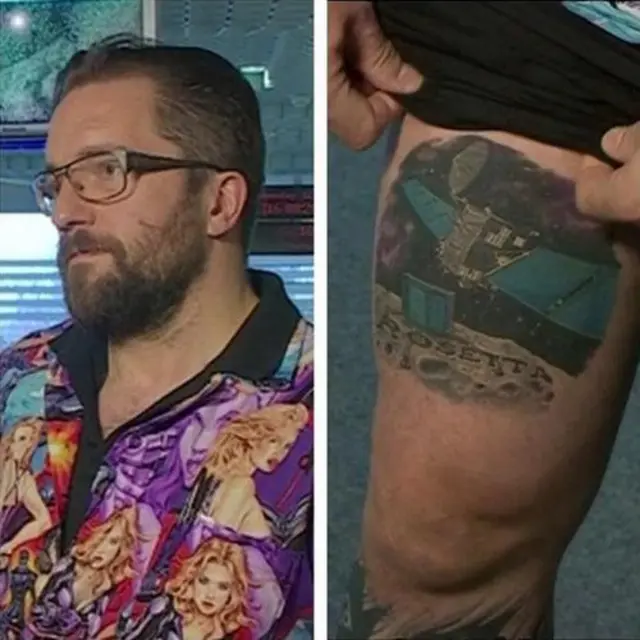Postpublished at 09:02 GMT 12 November 2014
Tense moments here - waiting for confirmation in the control room....
Confirmation received of the first ever comet landing
Successful touchdown of the landing robot Philae marks climax of 10 year, 6.4 billion km journey
Esa confirms the harpoons designed to attach Philae to the comet did not fire, but its smaller screws appear to have dug into the surface
Philae was released at 08:35 GMT and took seven hours to reach comet 67P
Pictures have been received of the descent in progress - more are now eagerly awaited from the comet surface
Live video from the European Space Agency's operations centre in Darmstadt, Germany
Jonathan Webb, Melissa Hogenboom and Victoria Park
Tense moments here - waiting for confirmation in the control room....
Dr Daniel Brown from Nottingham Trent University, external writes in to say:
"Although we have landed on planets, moons and asteroids, it has never been attempted for a nucleus of a comet - and with good reason. These objects have a very low gravity, are loosely composed of ice, dust and rocks, and are very irregular in shape. They are temperamental in their behaviour and notoriously difficult to predict.
"During the landing, and on the surface, the lander - about the size of a washing machine - will begin to analyse the comet with ten instruments. Apart from the amazing scientific results, the sheer challenge and ambition of such a mission is outstanding and illustrates how our space exploration of the solar system has become more advanced and successful.
"It gives us much to hope for in future missions."
tweets:, external Matt Taylor, @ESA_Rosetta project scientist on #CometLanding has the coolest tattoo (pic @BBCBreakfast):

tweets:, external We are now in separation window, expecting signal confirming that @Philae2014 has departed @ESA_Rosetta #CometLanding
 Jonathan Amos
Jonathan Amos
Science correspondent, BBC News
Three spindles driven by a common belt will push Philae away from Rosetta with a velocity of 18cm per second.
Think of the spindle that moves the inkjet head up and down inside your printer - Philae's ejection spindles are just like that.
If for some reason this system fails to operate, a back-up spring mechanism is automatically primed to fire 10 seconds later, to ensure the robot is booted off come what may.
A radio confirmation is expected at Earth just after 09:00 GMT. Remember the vast distance between us and Comet 67P means radio messages take 28 minutes to arrive.
tweets:, external There's a backup system - a spring - which should eject @Philae2014 with a short delay (10 secs) if the main system fails... #CometLanding
@GamerZeeSS tweets:, external @esa Best of luck on the #Philae landing to the Rosetta team. You've already achieved so much, this would be one hell of a cherry on top!
Philae should be separating from the lander any time now. But it will take about 28 minutes for any information to reach us here on Earth!
Good luck Philae....
@imbrianj tweets:, external Want to go to sleep, but we're landing on a freakin' comet right now. #rosetta #esa #space
The target landing site was chosen on 15 September and later christened "Agilkia" following a public competition.
Yesterday Esa released 10 amazing "favourite pictures, external" taken by Rosetta from 10km above the comet's surface, including this one.
 Image source, ESA/Rosetta/NAVCAM
Image source, ESA/Rosetta/NAVCAMWill the surface be hard or soft? Will Philae stick the landing?
Get in touch and let us know what you think.
 Jonathan Amos
Jonathan Amos
Science correspondent, BBC News
A little more on the cold-gas thruster issue on Philae:
Esa mission manager Fred Jansen says the "go" was given despite the failure because there was nothing to be gained by delaying the landing. In other words, the thruster would not be fixed by waiting another couple of weeks. Philae will just have to live with it.
Have faith in those screws and harpoons, though. And if parts of the surface are as fluffy as some suggest, the robot could nestle nicely in a "snow drift".
tweets, external: Yes! My @Philae_MUPUS instrument has been switched on. With its 3 sensors, it will study #67P surface material #CometLanding
 Jonathan Amos
Jonathan Amos
Science correspondent, BBC News
So, we start landing day with an interesting development, and an explanation as to why the third Go/No-go decision was delayed in the night. It concerned the health of the Philae lander.
Engineers report that all is good apart from the cold gas thruster that is used to push the robot into the surface of the comet when it touches down. It is designed to stop Philae bouncing back into space in the low-gravity environment.
This system could not be primed. It appears a critical valve would not open. What does it mean?
Stephan Ulamec, the lander chief from the German space agency, told me: "We will have nothing now pushing us into the surface. We will just have to rely now on the harpoons, the screws in the feet, or the softness of the surface. It doesn't make it any easier, that's for sure."
But the landing attempt goes ahead.
It's a crisp 10C in London, 7C in Darmstadt and as usual, about -70C on comet 67P. A good day for the European Space Agency (Esa) to try and make history.
A video feed from the agency's headquarters will appear in the "live coverage" tab above and we'll keep you up to date as the landing attempt progresses.